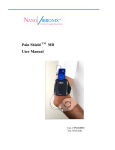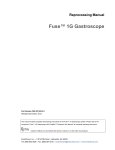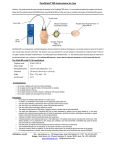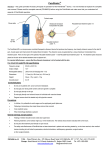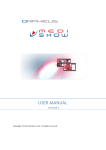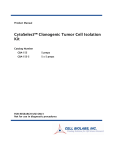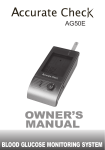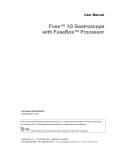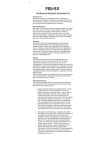Download UroShield - User manual
Transcript
UroShield ™ User Manual Cat. # USUM002 Ver.11 UroShield User Manual NanoVibronix Page 2 of 25 UroShield User Manual Table of Contents General Information.............................................................................................4 Introduction and background ...........................................................................4 Definitions........................................................................................................5 Clinical Information.............................................................................................7 Intended Use.....................................................................................................7 Patient Eligibility .............................................................................................7 Pre-Use Preparations............................................................................................8 General .............................................................................................................8 Preparing the Patient ........................................................................................8 Using the UroShield.............................................................................................9 Applying the UroShield................................................................................9 Activating the UroShield............................................................................11 Deactivating the UroShield ........................................................................11 Instructions for the Patient .............................................................................12 UroShield Description .......................................................................................13 UroShield Actuator.....................................................................................14 UroShield Driver ........................................................................................14 Magnetic field ................................................................................................15 Environment requirements .............................................................................16 Safety Information .............................................................................................18 UroShield Driver Indications .........................................................................19 Charging Requirement ...................................................................................20 Product Classification ....................................................................................20 Compliance with Standards............................................................................20 Storage and Maintenance...................................................................................21 Storage before Use / Expiration Dates ...........................................................21 Operational period..........................................................................................21 Re-use and Disposable ...................................................................................21 Troubleshooting .................................................................................................22 Frequently Asked Questions..............................................................................22 Service................................................................................................................23 Addresses ...........................................................................................................24 Representative in Europe............................................................................24 Appendix I .........................................................................................................25 Exclusion criteria ...........................................................................................25 Z–Shield for Percutaneous Nephrostomy ......................................................25 S–Shield for Suprapubic Cystostomy ............................................................25 NanoVibronix Page 3 of 25 UroShield User Manual General Information Introduction and background Catheter associated urinary tract infection (CAUTI) and other indwelling device associated infections are a major cause of morbidity and mortality in hospitalized patients. (1) Catheter acquired urinary tract infection is one of the most common types of catheter acquired infections and adds greatly to patient morbidity and medical cost. Urinary catheters may readily acquire biofilms when inserted. The longer the catheter remains in place, the greater the tendency of these organisms to create biofilms that result in urinary tract infections, which are difficult to treat. The initial step in biofilm formation is the adhesion or attachment of planktonic bacteria on the catheter surface. It is thought that bacteria use touch sensors to attach to a solid surface. (2) This occurs within a few hours after urinary catheter placement. After attachment the bacteria begin to interlock, a process known as docking. The bacteria then secrete an extra-cellular polymeric matrix (ECM), which allows them to survive and proliferate. The complex of the bacteria and its ECM now adherent to the catheter surfaces is known as biofilm. The established biofilm is highly resistant to antibiotics and to the body's immune system. In addition to the biofilm formation and it's sequele, indwelling urinary catheters are associated with pain, discomfort and spasm. Although there are catheters designed to reduce friction from placement and removal of the catheter, there are no interventions that actively and specifically treat the symptoms of pain, discomfort and spasm associated with urinary catheters. To date, in order to treat these symptoms patients are given systemic medications 1 Pugach JL, DiTizio V, Mittelman MW et al; Antibiotic Hydrogel Coated Foley Catheters for Prevention of Urinary Tract Infection in a Rabbit Model. The Journal of Urology, Volume 162, 883887, September 1999. 2 Princeton University News- Discovery of bacterial touch sensor could lead to Biofilm treatments. http://www.princeton.edu/pr/news/02/q1/0205-touchsensor.htm. NanoVibronix Page 4 of 25 UroShield User Manual such as NSAIDS and anti-spasmodics. UroShield represents a breakthrough in the treatment of urinary catheter related symptoms. The UroShield System (U.S Patent № 7, 393, 501) developed by NanoVibronix is intended to prevent bacterial biofilm formation by means of surface acoustic waves that it generates. In addition, UroShield decreases the pain, discomfort and spasm associated with indwelling urinary catheters. A number of studies have shown promising results in the treatment of biofilm based sequele using ultrasound energy. The UroShield System is a disposable medical device that can be used to diminish biofilm. The acoustic waves generated by UroShield on the surfaces of the catheter interfere with the attachment of bacteria, which is the initial step in biofilm formation. In addition, UroShield increases antibiotic efficacy against biofilm bacteria. All these characteristics make UroShield an ideal device to prevent or treat catheter related injury. Definitions Biofilm – Communities of microorganisms, attached to a surface. Driver – Electronic unit that provides the electronic signal to the Actuator. Actuator – Piezoelectric element device, which converts the electronic signal to acoustic waves (mechanical waves). NanoVibronix Page 5 of 25 UroShield User Manual WARNING! Identifies situations or actions that may affect patient or user safety. CAUTION! Points out special procedure or precautions that must follow to avoid equipment damage ATTENTION! Stresses that the following note should be clearly understood by the user or patient before using the device. Important Notices WARNING! UroShield should only be used in the manner prescribed in this User Manual. WARNING! The unit is classified as internally powered, continuous operation; ordinary equipment with disposable type BF applied part. The device is not intended for use in the presence of flammable mixtures. CAUTION! Safety for the Lithium ion rechargeable batteries only: do not disassemble, heat above 100ºC, incinerate or expose contents to water. CAUTION! Device with catheter should be put to use and operated by skilled professional. NanoVibronix Page 6 of 25 UroShield User Manual Clinical Information Intended Use The NanoVibronix™ UroShield™ is a low-energy, battery powered generator of acoustic waves designed for application to the extracorporeal segment of an indwelling siliconized latex, silicone orlatex urological catheter for up to 30 days. The UroShield surface acoustic waves are intended to discourage bacterial adhesion and colonization on the catheter surfaces and to disrupt biofilm formation. The UroShield is also intended to decrease pain and discomfort associated with urinary catheter use. UroShield is indicated as an accessory to indwelling urological catheters. UroShield is not intended as a treatment for active urinary infection. Patient Eligibility Any patient requiring the insertion of an indwelling silicone coated latex urinary catheter. NanoVibronix Page 7 of 25 UroShield User Manual Pre-Use Preparations General 1. A fully charged UroShield driver has an operation life of - 24 h and should be replaced by fully charged driver. The used driver should be only charged using the supplied charger. 2. Should the actuator become soiled; it should be cleaned with a slightly damp sponge and be allowed to air dry. Preparing the Patient Before attaching the actuator onto the urinary catheter, the catheter must be inserted into the patient. NanoVibronix Page 8 of 25 Using the UroShield Applying the UroShield 1. Once the urinary catheter has been placed into the patient's bladder in a standard fashion, open the actuator wrapping. The application of the UroShield on the catheter must be done with gloves. The UroShield actuator can only be used with urinary catheter sizes 14,16,18,20 and 22 French. 2. Gently pull on the urinary catheter until you feel some resistance. Figure 1: Catheter Positioning 3. With the UroShield open, peel off the protective strips from both sides of the actuator. (Figure 2 below) Figure 2: Adhesive strips removal UroShield User Manual 4. Estimate 2 to 3 cm (about 2 finger-breadths) away from the point the catheter exits the body in females. In males estimate 5 to 10 cm (about 4 finger-breadths) (Figure 3 below) and place the actuator over the catheter, so that the catheter enters and exits the actuator in the semi-circular grooves at each end. Always ensure that the direction of the actuator active cord is towards the patient (Figure 3 below). Figure 3: Actuator positioning 5. Once the actuator is in place, close the actuator carefully, until the two sides snap together (Figure 4 below). Ensure that the catheter has not been deformed or pinched at either ends of the actuator. Figure 4: Actuator locked in place NanoVibronix Page 10 of 25 UroShield User Manual Activating the UroShield 1. Plug the actuator connector into the driver output socket. Ensure that it is fully inserted and secured (Figure 5 below). ON/OFF button Figure 5: Actuator Electrical Connection 2. Press the ON/OFF button on top of the driver. Note the blinking green light, which indicates that the system is working. 3. Fasten the Driver around the patient's waist or place next to patient on bed. 4. The hospital staff should check the LED indicators on the driver during each hospital shift. Deactivating the UroShield 1. Press the ON/OFF button till you hear a beeping sound. 2. Once the driver is off, no LEDs should be blinking. NanoVibronix Page 11 of 25 UroShield User Manual Instructions for the Patient 1. Instruct the patient not to pull or open the UroShield actuator at any time. 2. Instruct the patient not to disconnect the cord that connects the actuator to the driver. 3. Instruct the patient not to press the ON/OFF button on the driver unit. 4. Instruct the patient to inform the nursing staff if any alarms are heard or he/she notices that the green light has stopped blinking 5. If patient is showering, the driver should be disconnected and removed, while the actuator can remain on the Catheter. Immediately after the shower the driver should be reconnected. Should the actuator area become soiled, cleaning can be done with a slightly damp sponge and allow it to air dry. NanoVibronix Page 12 of 25 UroShield User Manual UroShield Description The UroShield System is comprised of two main components: 1. The Disposable UroShield Actuator – a disposable, small, lightweight clipon actuator, which is attached to the Foley Catheter after the catheter has been inserted into the patient. The actuator receives energy and a signal from the UroShield Driver. 2. The UroShield Driver – an external driver unit, which supplies electrical signals to the UroShield Actuator. The driver unit contains batteries to power the system and firmware that control the functionality of the actuator unit. The driver is small, lightweight and can be placed on the patient bed, or worn on a belt if the patient is ambulatory. The UroShield Driver should not come into contact with the patient's skin. Two additional members of the UroShield™ family of products are the ZShield and S-Shield patches. These are therapeutically active stabilization patches intended to be used with percutaneous nephrostomy and supra-pubic cystostomy catheters. See additional details in Appendix I NanoVibronix Page 13 of 25 UroShield User Manual Product Specifications The UroShield is supplied as a kit that contains two Drivers, separately sealed actuators and power supply (charger). UroShield Actuator Dimensions L x W x H: 42 x 34 x 15mm Weight: 20 grams (including cable) Housing: Polypropylene UroShield Actuator UroShield Driver External dimensions: 90 mm x 53 mm x 35 mm Weight: less than 250 gr. Housing: ABS box Batteries: Lithium-Ion rechargeable batteries Belt strap 43'' long with clips is available for the UroShield ambulatory patients UroShield Driver NanoVibronix Page 14 of 25 UroShield User Manual UroShield Actuator Catheter UroShield Driver UroShield System UroShield operating modes: Working mode – activated by pushing the ON/OFF button. If an actuator is connected, power is applied to electrical circuitry. If no actuator is connected, the system generates audible and visual alarms. Off mode – No power is provided to the actuator. Charging mode – external power supply is connected. The system should be in Off Mode (no signal to Actuator). Magnetic field The system emits low energy onto the inner and outer surfaces of the urinary catheter. It complies with the requirements of IEC-60601-1 and EN60601-1-2 standards. NanoVibronix Page 15 of 25 UroShield User Manual Environment requirements Temp: 0º-40ºC. Humidity: 20-85%. Labels The following labels are attached to the system: Driver Actuator URO S HIELD ║ DRIVER Model UD-12A Power No Output LOT D12A S/N Note: Use only the supplied adaptor for recharging NOT WATERPROOF ! NanoVibronix Ltd. 47 Hataasia St., Nesher 36603, Israel U.S. Pat. № 7, 393, 501. Patent pending V NANO IBRONIX ║ Curing through prevention UroShield Labels NanoVibronix Page 16 of 25 UroShield User Manual Symbols Class BF applied part Do not reuse Caution, consult accompanying documents Manufacturer Authorized representative in the European Community Use by YYYY-MM CE mark S/N Serial number LOT Separate collection for electrical and electronic equipment Rated frequency or rated frequency range(s) (Hz) NanoVibronix Page 17 of 25 UroShield User Manual Safety Information This product was designed and manufactured to ensure maximum safety of operation. It should be operated and maintained in strict compliance with the safety precautions, warnings and operating instructions contained in this manual. There are no user serviceable parts in this system. If your product does not operate as expected, please contact your local representative. The UroShield driver and actuator are not MRI compatible. Before entering the MRI suite, the Driver and Actuator should be turned off and then disconnected from the patient to insure that it is not within the area of the MRI magnetic field. Before using this device, the operator must be familiar with the operator instructions and safety precautions listed here and throughout the manual. If the product does not operate properly or if it fails to respond to the controls as described in this manual, the operator should contact the local representative. WARNING! Do not use the UroShield as a treatment for active urinary infection. CAUTION! The UroShield driver is not waterproof! If the patient wishes to shower, the driver should be disconnected and removed, while the actuator can remain on the Catheter. Immediately after the shower the driver should be connected. NanoVibronix Page 18 of 25 UroShield User Manual Switch and Alarms Audio visual indication of proper operation or malfunction: Indication Meaning Blinking green light The system is working. 5 green LED bar is full Battery is fully charged. The lower LED at the LED Low Battery – charging required bar is blinking and audible The indicators' Light has no influence over the alert in on acoustical action. Red LED Actuator disconnected (no load) Audible alarm Low battery or Actuator disconnected Blinking green light 5 green LED bar Red LED UroShield Driver Indications NanoVibronix Page 19 of 25 UroShield User Manual Charging Requirement To recharge the Driver use only the provided power supply. Product Classification Low risk device classification: CE mark – Class IIa. Compliance with Standards IEC 60601-1:2001 IEC-60601-2:2001. ISO 10993. NanoVibronix Page 20 of 25 UroShield User Manual Storage and Maintenance Storage before Use / Expiration Dates The system may not be exposed to extreme environmental conditions; therefore, the UroShield system and accessories must be stored in its shipment box under standard conditions: Temp: 10º - 30º C Humidity: 20 - 55 % Disinfection of the disposable actuator is warranted up to 1 year. The driver battery shelf life is warranted for 2 years, if kept in original packing. Operational period Urinary catheters are to be replaced according to the clinical guidelines of the physician or health care facility. The driver unit comes with 1 year warranty. Re-use and Disposable The driver unit must be wiped clean by 70% alcohol pads in between patients. The actuator is for one-time use; no sterilization is required. The device does not contain toxic or hazardous material or recyclable material. The actuator must be disposed of together with the catheter, onto which it is clipped, according to local clinical standards. NanoVibronix Page 21 of 25 UroShield User Manual Troubleshooting Problem Required action The lower LED at the LED bar Low Battery – charging required. is blinking and audible alarm is Replace driver with other charged driver. on Red LED is on Actuator disconnected - Ensure that actuator wire is plugged into UroShield driver. Audible alarm Low battery – charging required or Actuator disconnected - Ensure that actuator wire is plugged into UroShield driver. Frequently Asked Questions Question Answer Can the UroShield be used No, it can only be used with 14, 16, 18, 20, with all types of catheters? 22 French Siliconized Latex urinary catheters. Is it OK to reuse the Actuator No, the actuator is for-one time use only. if I disinfect it? NanoVibronix Page 22 of 25 UroShield User Manual Service A faulty unit, which is under the warranty period, can be sent to NanoVibronix for replacement. NanoVibronix Page 23 of 25 UroShield User Manual Addresses NanoVibronix Ltd., 9 Derech Hashalom St. P.O.Box 515, Nesher 36651, Israel. Tel: +972 – 4- 8200581 Fax: +972-4-8202794 NanoVibronix Inc., P.O.Box 507, Cedarhurst, NY 11516, USA. Tel: 516-5696872 Representative in Europe MEDNET Gmbh PHONE: 49-251-32266-0 Fax: 49-251-32266-22 POSTAL ADDRESS: BORKSTRASSE 10, 48163 MUNSTER, GERMANY. E-MAIL ADDRESS: [email protected] NanoVibronix Page 24 of 25 UroShield User Manual Appendix I Additional Urology Applications Two additional members of the UroShield™ family of products are the ZShield and S-Shield patches. These are two additional therapeutically active stabilization patches intended to be used with percutaneous nephrostomy and supra-pubic cystostomy catheters. Exclusion criteria Injured or diseased skin in location of patch intended placement. Known sensitivity to medical grade adhesive. Z–Shield for Percutaneous Nephrostomy Z-Shield patch is an acoustically active stabilization patch designed to stabilize percutaneous nephrostomy catheters and apply low frequency ultrasound to the nephrostomy tube to decrease biofilm and maintain patency. At the same time the Z Shield patch administers low frequency ultrasound to the puncture site to decrease pain and discomfort associated with percutaneous tubes such as nephrostomy. These tubes cause a marked decrease in quality of life for patients as well as frequently precipitate urgent medical need to maintain tube patency or to exchange the tube for a new one. S–Shield for Suprapubic Cystostomy S-Shield patch is an acoustically active stabilization patch designed to stabilize percutaneous cystostomies and apply low frequency ultrasound to the abdominal wall opening as well as to the inserted catheter. The goal of the device is to minimize negative ostomy reactions around the skin opening as well as to minimize biofilm and subsequent infection. In addition, the S Shield patch is designed to decrease pain and spasm associated with percutaneous cystostomy catheters. Z-Shield Patch Model PZP-10 S-Shield Patch Model PSP-10 WARNING! Patches replacement should be done periodically according to physician’s order and not longer than after 30 days. NanoVibronix Page 25 of 25


























